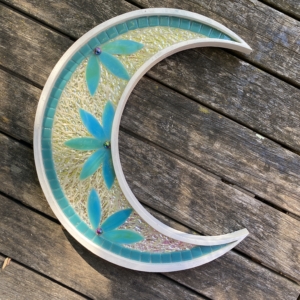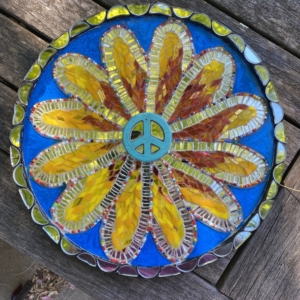Litokol® Translucent Grout – Information
This is an incredibly easy to use product.
- It is safe for fish, bird and animal life, and is also food safe.
- Starlike® Crystal EVO is not classified as hazardous goods and is, therefore, exempt from transportation restrictions (ADR-ADN-IMDGIATA classes).
- Product with ultra-low volatile organic compound emission rate (VOC) compliant with class A+ according to the French Regulation and class EC1 PLUS according to the EMICODE protocol.
- Contains ≥ 50% of recycled material.
- It is readily cleaned up with water (and yes, you do need quite a bit). It is nothing to be scared of.
In the first part of this article, I address important things such as packaging, quantity required, mixing instructions & clean-up, and shelf and pot life.
The second part of the article addresses some misconceptions that are published on Facebook about the product.
Basic information about this product:
1) Packaging:
The tub contains a paste (the greyish-white gritty substance), then a liner/divider (it is NOT an inner lid), some instructions (translated from Italian, and designed for single use applications – not for portioning out – not very helpful for mosaic artists) and a sachet of catalyst or hardener. During shipping, the contents may get tossed about, and the paste may get into the upper area. Just scrape it back down into the base of the tub. There is nothing wrong with the product!
2) How much grout to mix up:
The easy answer is to use roughly the same amount as you would with sanded grout. I have found that it seems to take slightly less than you would use of cementitious grout.
I have developed an Epoxy Grout Usage calculator for use with Litokol grouts. It is available to download for free here. It works in metric (millimetres/grams) and imperial (inches/ounces) measurements.
Use this, and you’ll probably be safe and have some leftover. Of course, It’s going to vary. If you are working with 3D pieces, you’ll have to work out an equivalent flat area.
3) Mixing ratios:
Simply put, you use a mixing ratio of 15:1 (15 parts Paste, 1 part Hardener) – a total of 16 parts.
– This roughly equates to the manufacturers ratio of 93.7 (Part A – paste) to 6.3 (Part B – hardener), allowing for rounding.
Divide the quantity of grout you require (Step 2 above) by 16 to get the total of Part B, then add enough Part A to get to the total quantity required (divide by 16, multiply by 15). This works the same in oz as it does in grams, as it is proportional.
Using the example from the above point, you would need:
- METRIC: 30cm square would require 140gms total, which is 8.75 gms (140/16) Part B, and 131.25 gms Part A
- IMPERIAL: 12 inches square would require 5 oz total, which is .31 oz (5/16) Part B, and 4.69 oz Part A
4) Application & Clean-up:
– The product is very easy to clean-up. If you use enough water, you need very little pressure to clean it off.
– Apply the product much as you would any other grout. If you are working on a large piece, you can grout in sections.
– Once you have applied the product you:
- Apply water with a WET scourer pad, rubbing lightly in a circular motion. The in-built cleaner does all the work.
- Wipe off the white residue with a wrung-out sponge, and leave 15-20 mins or so (This allows your grout to slightly cure, and thus become firmer, making this cleaning process a bit easier).
- Then do your detailed clean (as you would with any grout).
- I use a pick or mini scraper (the same ones I use with cement grout), and a dampish scourer pad.
- I advise having a spray bottle of water on hand.
- An old, soft toothbrush is very useful for cleaning off work that has varying heights and/or small, sharp pieces.
- Wipe over with a slightly damp sponge
- I always finish with a (quick) dry polish with a soft t-shirt.
- Do not allow water to dry on the surface.
5) You can add in more grout before it cures
– If you have not mixed enough grout, you CAN add more before you commence cleaning.
– When you are cleaning it off, if you pull out too much, DO NOT add more grout in. You risk trapping moisture under the patch, and it can crack off in time.
– Wait until it is cured, and cleaned, then smooth on a small amount.
6) Shelf and Pot life:
– Shelf life of the product is 24 months in original packaging when stored in a dry place
– The mixed product has a pot life of approximately 1 hour at a temperature of about +23°C.
– Recommended Application temperatures: from +10°C to +30°C – Optimal: from +18°C to +23°C
Watch me using the product, including ‘undergrouting’ with a cementitious grout (Litokol StyleGrout Tech):
Misconceptions and mis-information:
There are some mis-conceptions about this amazing product. As you read these, you will see there is a fairly common thread coming through – “USE. MORE. WATER”. I can’t stress that enough! Some of the ill-informed suggestions I have seen, and the correct responses are listed below. I’ll add to this as I hear of more.
1) Add more hardener: so it dries properly!
– This wasteful. You will end up with left over paste (Part A)
– Will also make it harder to clean off, as it may cure more quickly.
– In Australia you can buy extra hardener (Part B) sachets from Merlin Mosaica.
2) You don’t need a lot of water.
– Yes you do… if the scouring pad is sticky, USE. MORE. WATER.
– Water is an integral part of the cleaning process.
– Professional tilers flick water onto the tiles before they begin to clean off. I LIGHTLY squeeze out my scourer sponge to stop the water dribbling down my arm. That’s it.
– Another tip is to have a spray bottle of water handy – spray the work at the start of the cleaning process. Re-spray if it feels too sticky!
– Water activates the inbuilt cleaning agents, and the product comes off with almost no pressure. It emulsifies (turns white).
– Wipe this white film off, and then go back in for a detailed clean 15-20 mins later (with wet scourer & a pick tool) as you would any normal grout.
– Polish with a soft, dry cloth. Old T-shirts are ideal.
3) If your grout lines are too wide, the grout will fail.
– No it won’t, but you WILL get a frosted grout look.
– This is fine if by design (as I have done).
4) If your grout lines are too wide you will get a yucky, creamy mess that will visually fracture your work (posted by someone who has NEVER used the product).
– No, you will get a frosted glass look.
– Yes, depending on the colour of the tesserae you may get visual fracturing, just as you would if you used the incorrect cement grout colour.
5) You can use vinegar or acetone to clean it.
– Pre-cure you could, but you don’t need to as it has no effect on the product.
– The inbuilt cleaner makes it a breeze to clean (as long as you haven’t used too much hardener).
– Once it cures fully, vinegar or acetone will have no real effect. Steel wool might, but not much else.
– In, fact, the vinegar may etch the surface of your glass.
6) The grout takes away the shine of your glass.
– No it doesn’t. Clean it off properly, and your glass sparkles as it should. Have a look at my Luna moon or Myr below – they sparkle.
– Mix grout correctly, according to the mixing ratios posted by the manufacturer. Peter Twining has remarked that the grout seems to make iridised glass more sparkly – and I have noticed this effect too.
– USE. MORE. WATER.
– NOTE: Both the pieces mentioned above were done on MDF – not a friend of water. I cleaned them up with no issue, and the substrates have not been compromised.
7) The grout looks like silicone (posted again by someone who has never used it)
– No, it looks like frosted glass.
– It IS 50% glass (micro beads).
8) The grout stays sticky.
– No it doesn’t.
– Mix according to the manufacturers ratio.
– Use more water.
– I can’t stress this too strongly.
– USE. MORE. WATER.
– Another tip is to have a spray bottle of water handy – spray the work at the start of the cleaning process. Re-spray if it feels too sticky!
9) The mixing proportions are just made up by someone.
– The mixing proportions come directly from the manufacturer.
– They are readily available in the product data sheets, which I include in my product listings.
10) You can paint over the top of it.
– This grout is NOT porous as is cement grout, so paint won’t absorb in as it does with cement grout.
– However, we have recently tested acrylic paint over the surface of epoxy grout for a client. The paint does stick, BUT may well fade in time. Also, we are unable to comment on the potential for the paint to peel off.
11) Because of the water required in cleaning, you can’t use it with a water soluble glue.
– You definitely can.
– The grout forms a barrier between the adhesive and the water.
– The clean-up process only removes the superfluous product from the top.
12) The grout isn’t very strong, and will crack.
– This grout is VERY strong.
– I just recently re-read post from a year ago where Gabriella Grama Mosaic Art used it on a mosaic done with Weldbond (I think) onto a photograph. Once it dried, she turned the piece over, and sponged off the paper, leaving a rock hard slice of grouted glass, which she then affixed to a Wediboard backer.
13) I can use oxides to colour this grout
– Actually, you can’t. Oxides are for cement grout.
– Epoxy grouts may possibly be coloured with resin colourants, although the manufacturer does not recommend the use of any additives. Always perform a test piece first.
– Colouring this grout will negate the colour transference effect, so is not advisable.
14) I can add glitter to this grout?
– No, you can’t. Litokol do make a glitter additive for some of their coloured grouts, which is NOT suitable for the translucent grout.
– However, whilst wet, I have touched up the surface with a sponge dauber dabbed into some glitter. Have a look at my Christmas tree photo below.
15) I can use Litokol Crystal Starlike EVO (translucent) grout as an adhesive.
– No, you can’t.
– Litokol’s Starlike EVO (coloured) epoxy grout can be used as an adhesive, but the Crystal (translucent) cannot.
– As it is 50% glass, it’s not able to be used as an adhesive.
16) It will never replace cement grout.
– This is actually correct.
– I have never suggested that it will replace cement grouts.
– In dark works, or ceramic works it is not recommended, nor (typically) where grout lines are more than 3mm, nor in works where solid grouting is part of the plan or design.
– It comes into its own where a blended look is desired.
– It can be used in conjunction with cement grouts, as Jacque Towner Mosaic Art and Mosaics by Awan have both done.
– Use the cement grout first, then translucent over the top. It provides a protective layer that negates sealing.
17) Epoxy grout is too slippery to use in bee baths.
– The translucent epoxy grout is 50% glass micro-beads, and has a definite textured finish, although not as gritty as sanded grout.
– The coloured epoxy grout is made with a baked aggregate (containing the colour), which also has a textured finish.
– As an aside, the tesserae most of us use are very smooth, so this argument really doesn’t hold water (hehe).
18) Epoxy grout is toxic for Bees and Birds and other animals.
– Litokol epoxy grout products live up to the claim of being non-toxic and safe for installers, animals, and for the environment as a whole. They have been installed in ponds throughout Europe for many years.
– The Technical Data sheets refer to fish toxicity, but this is in relation to the individual, uncured components. Once mixed and cured, the product is non-toxic and food-safe.
19) Epoxy grout is not designed for beginners.
– I do not recommend this grout for beginners. Whilst it is not difficult to use, it does require a different clean-up method, which may confuse “newbies”.
– Also, as it is more expensive than cementitious grout, it is better to practice and experiment with a cheaper product.
20) You need to buy a special sponge and even a cleaner to clean it up.
– Whilst I do recommend the scourer sponges for clean-up, they are inexpensive. I also cut them in quarters, to get more use from them.
– The cleaner is only ever required as a last resort, if you haven’t used enough water to clean-up. Under normal circumstances it is never required.
21) The translucent reflects colour for glass-on-glass (GOG), but there is no information about non GOG in the Litokol Data sheets.
– This is very true. However, the product is primarily used for swimming pools and/or bathrooms, and in my experience, most of those are not made from glass (although the tiles used are). It is designed to be used on opaque surfaces.
22) If your grout lines are larger than 3mm, then it’s cream grout and in some instances looks grey, although the data sheet says cream.
– If your grout lines are wider than 3mm, the grout will show a greyish white – similar to frosted glass. The cream in the data sheets refers to consistency, not colour.
23) Epoxy grout is shiny
– actually no. It has quite a texture.
24) The grout is not food-safe.
– Actually, Litokol Epoxy grouts ARE fully food-safe once cured.







Hi can you please send a link to the Mosaic that Gabriella Grama Mosaic Art made with the photo transfer method? Thank you for you time and informed article.
https://www.facebook.com/groups/merlinmosaicacustomers/permalink/851721756059316
Is there a special sealer to use with this product, or will any do?
As an epoxy grout, this product does not need to be sealed, ever.
Cypress, Epoxy grouts do not require sealing, ever.
Thank you for your article. I absolutely did the newbie epic fail and didn’t use enough water. Now I have the haze on the glass. Can you recommend the “cleaner” mentioned above? What type is it and where can it be purchased? I’m in the US. Thank you.
Barbara, Litonet Gel is the cleaner. I sell it here in Australia. In the US, I suggest you contact the distributor (The Tile Doctor), or do an internet search for it.
Hi: I will be trying the Starlite Evo translucent grout for the first time and I am not sure how to figure the amount of grout I will require for my mosaic. Is there a way to figure out the quantity needed? your help is much appreciated.
d
Diane: the ratio is 94% of the paste, to 6% of the hardener. So if, for example you needed 16oz of grout in total, you would use 16oz*.94 (approx. 15.05 oz), and top up the remainder to 16oz with the hardener
hi: How do I calculate the amount of grout I will need? hopefully, you can help and let me know. Thank you Diane
The same as any other grout.
Please reply with a photo of the Scourer sponges you mention. Thank you for this article!
https://merlinmosaica.com/product/soft-sponge-scourer/